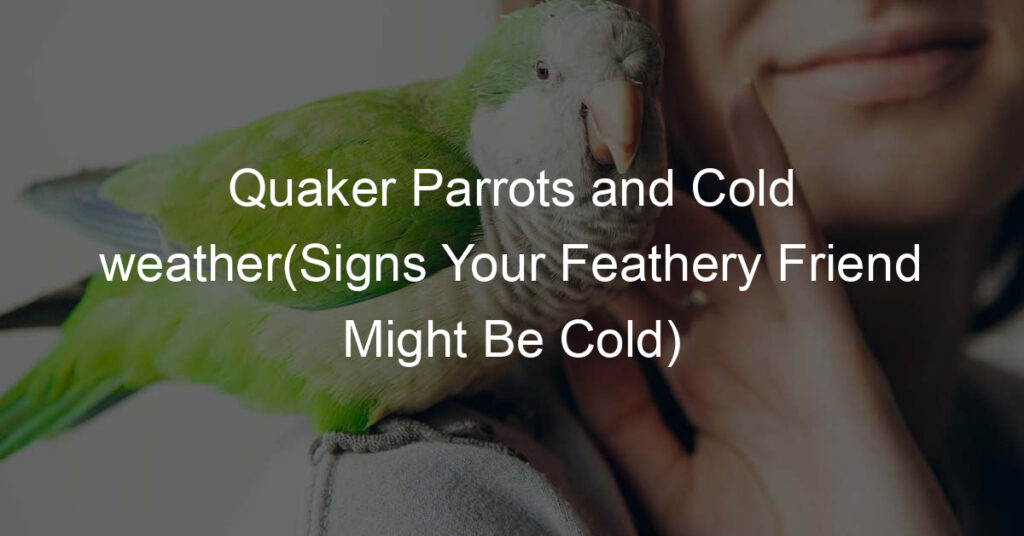Is your Quaker parrot shivering? Do they seem lethargic? These might be signs that your feathered friend is cold. While our little green pals are from tropical regions and prefer warm weather, they can adapt to cooler temperatures.
However, there are some things you should look out for to make sure your parrot stays healthy in the winter months. Here are some signs that your Quaker parrot might be cold.
Do parrots catch a cold?
It’s a common misconception that parrots can catch a cold, but in reality, these birds have evolved to be very resistant to most things that we consider common illnesses. They are actually quite resilient, making them surprisingly hardy animals. This is why they’re such popular pets – it takes a little extra effort to look after their health needs, but the reward of having a healthy pet parrot is definitely worth it.
It’s important however not to forget that no animal is completely immune to disease and regular vet check-ups should still be done for your pet parrot. In this way, you can ensure that you are caring for the health of your feathered friend in the best way possible.
Do parrots shiver when cold?
It may surprise you, but parrots are surprisingly sensitive to temperature changes. They often rely on a process called “shivering thermoregulation” to help regulate their body temperatures – yes, even parrots shiver when it’s cold! Unlike mammals, which maintain a consistent core body temperature, parrots have the ability to raise and lower their body temperatures depending on the environmental conditions.
This means that when parrots sense cold temperatures, they will use shivering to warm themselves up as quickly as possible. Such an impressive ability shows how in-tune parrots are with their environment. Next time you see one of these feathered friends out in the wild, take pleasure in knowing just how resilient and adaptable they can be!
How do I know if my Quaker parrot is cold?
Knowing if a Quaker parrot is cold can be tricky because they will usually not show direct signs of discomfort due to their natural instinct to hide symptoms of illness. However, there are some subtle hints that may indicate your parrot is too cold. Pay attention to your bird’s behavior and take note if they become more lethargic than normal, or fluff up their feathers more than usual; in both cases, this could mean they need additional warmth.
Additionally, look out for visible shivering as another red flag. Lastly, research the ideal temperature range that is suitable for a Quaker parrot’s environment and ensure you meet those parameters to keep them happy and healthy.
How cold is too cold for a Quaker parrot?
Quaker parrots, also known as monk parakeets, can handle a wide range of temperatures with an optimal comfort zone between 55 and 75 degrees Fahrenheit. That being said, anything below 50 degrees is certainly too cold for them! If you’re considering one of these adorable birds as a pet it’s important to make sure that their home environment will stay within their preferred temperature range.
Even if your area doesn’t usually drop below 50 degrees, make sure to check the temperature in the space where your Quaker parrot will be housed. If the temperature does dip below this level you’ll need to take steps to provide supplemental heating for your new feathered friend!
Can Quaker parrots survive cold?
Quaker parrots are often considered tropical birds, but contrary to popular belief, they can actually survive in colder conditions. How do these feathered friends manage to survive? They make sure to stay warm with enough food and shelter available. Fortunately, their thick feather layers help them with insulation as well!
These curious creatures can also protect themselves from the harsh elements by huddling together in a flock or finding roosts located near winding power lines and other heated sources. Not only that, Quaker parrots have proven to be incredibly adaptable; they are always on the lookout for smarter ways to cope with cold weather. All in all, it’s no wonder why Quaker parrots have been able to thrive under challenging environmental factors!
Final Takeaways
Overall, it is important to observe your Quaker Parrot for signs and symptoms that indicate cold temperatures. Make sure to take the necessary precautions if you suspect your feathered friend may be too cold. If feeling extra chilly, try to give them a warm snuggle. Keeping an eye on their behavior can help identify any changes they may experience during the winter season.
And remember the key to safekeeping them warm and happy lies in ensuring their enclosure remains at a comfortable temperature. Furthermore, providing insulation-like perches, blankets, and toys can also help with keeping their environment cozy. All in all, taking into account these measures enables you to make sure that your beloved Quaker Parrot stays warm and has a happy winter season!








